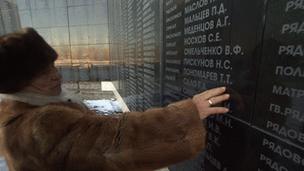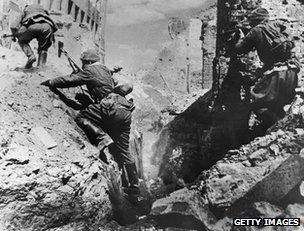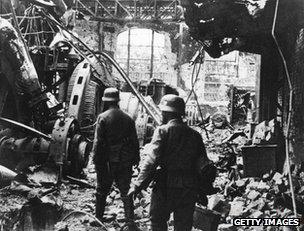Remembering the horrors of Stalingrad
- Published
As many as one million soldiers are believed to have died in the six months of intense warfare
As the Russian city once known as Stalingrad (now Volgograd) prepares to mark 70 years since the end of the famous battle against Nazi Germany, some of its survivors spoke to BBC News about their experiences.
At the centre of the commemorations is an ancient Tatar burial mound called Mamayev Kurgan, still the highest point in the city that once bore the name of Soviet leader Josef Stalin.
Commanding a spectacular view over the River Volga, it was one of the most important strategic sites during the battle and was fought over bitterly. Tens of thousands of bodies are still entombed in the hill.
On top of the mound is a vast statue to the Mother of the Nation, bearing a sword and apparently urging the Red Army on to victory, but 50 metres (yards) down the slope is the solemn Hall of Heroes.
Here, throughout the day, four Russian soldiers stand guard over a giant eternal flame in a round chamber, with the names of many of the Soviet dead written in gleaming mosaics on the wall. The sounds of heavenly chanting are played through hidden speakers in the wall.
Bodies from the battle are still being found all over the city and there are relatives still discovering where their fathers, brothers, mothers and sisters were buried.
Father missing

Valentina Savelyeva spent her life trying to find out about her father
Valentina Savelyeva is 75. For 67 of those years she was looking for the site of her father's body. He had been an anti-aircraft gunner during the Battle of Stalingrad and went missing in action. His body was found in 1961 and reburied in Mamayev Kurgan. But through incompetence or neglect, the Soviet authorities never told her mother.
After her mother's death she continued her search through the military commissariat, and the local museum. Eventually she found what she was looking for in a computer record at Mamayev Kurgan - just two miles (3km) from her home.
Now her father's name, TT Ponomarev, has been inscribed long with 17,000 other new names on a section of the memorial that has been added for the 70th anniversary.
"They have only started putting up these plaques now," she complained, the tears running down her cheeks.
"Seventy years after the battle - with my generation dying out and my mother already dead. And it turns out that all along we lived so close to this hill, without knowing my father was buried here. "
"No-one seems to care about our fathers and that has always haunted me. And I am still angry. I feel like I have been travelling for a long time, but I arrived late for his funeral. There is no joy or satisfaction. It's good that he is here. I know where to go but I have a feeling inside that I missed something, that I came too late."
Valentina Savelyeva's first memories are some of the most terrible that a child can experience.
Brother lost

The battle is remembered for ferocious street fighting
She was five years old when Adolf Hitler's Sixth Army stormed into Stalingrad in the summer of 1942. Soon her home was destroyed in the brutal street fighting. In November, as winter set in, she and her mother fled to a nearby ravine leading down to the Volga.
"When I close my eyes, I can see the Volga on fire because of spilt oil," she says.
"We dug holes in the clay to live in - not trenches, but holes, like real animal holes. Soon there was heavy fighting inside the ravine. German tanks moved up and down, while female Soviet pilots dropped bombs on them, and therefore on us. Everything was on fire and we heard thunder and planes roaring.
"The most horrible moment was around 20 November when the Germans broke through down the ravine towards the Red October plant. It was very scary.
"At first we just sat there in our dugouts, then our parents went out to help the wounded with their disjointed limbs. They would bandage the hands and legs, then medical staff would appear and take them away. Down by the Volga there was a hospital."
There was no food, only the local mud, which happened to be slightly sweet.
"We ate clay and nothing but clay," she explained. "And we drank water from the Volga. My mother would throw away the bits of clay that were soaked in blood, and then take the rest and filter it through a piece of cloth."
The sugar in the clay kept her alive, but not her little brother who died of hunger and cold.
Pincer movement

Germans took most of the city before getting trapped by the Soviets
The Sixth Army had pushed through the southern Soviet Union at breathtaking speed, heading for the Caucasus where there was oil, and also for Stalingrad, near the mouth of the strategic River Volga.
There it was that the Red Army made its stand, clinging on to ever-narrower strips of the west bank of the river. The order from Stalin was "No surrender". The order from Hitler was "No retreat".
The exact figure for how many soldiers died in Stalingrad is hard to estimate, but it is probably close to a million. The fighting was at incredibly close quarters in the ruins of a once-mighty industrial city. Big guns, tanks, and aircraft were all used against the men standing their ground in the rubble.
The German troops got bogged down in the street fighting as winter closed in. Their commander, Field Marshal Friedrich Paulus, suggested a tactical retreat but Hitler refused.
The Soviet troops secretly massed to the East and the North. Then, in a classic pincer movement, they cut off the Sixth Army from its supply lines. Slowly the mighty force that had taken Paris starved and froze to defeat.
Narrow escape
In 1942 Konstanin Duvanov was a soldier of 19. He had retreated all the way from Ukraine with the Red Army back to his home city, Stalingrad. One of his most vivid memories of the almost unrecognisable city was also the burning Volga.
"Everything was on fire," he says.
"The bank of the river was covered in dead fish mixed with human heads, arms, and legs, all lying on the beach. They were the remains of people who were being evacuated across the Volga, when they were bombed."
Konstantin Duvanov fought on in Stalingrad until the end of the battle.
By chance he was in the city's Red Square guarding a captured German communications vehicle when - on 31 January 1943 - Paulus surrendered in the basement of the Univermag department store, and was led out to a Red Army car.
"Half an hour later," he recounts, "we saw a sergeant carrying three captured German machine guns over his shoulder.
"He went up to the car and saw Paulus inside. He said 'Ah! The general who killed so many people just sitting there in the car as if nothing happened'. So he loaded a machine gun and aimed it.
"Paulus opened his mouth and became white as paper. Because you know - in one millisecond there would be no field marshal. But suddenly a lieutenant emerged and pushed the machine gun away. He shut the the car door and shouted to the driver: 'Move for God's sake, otherwise he'll be killed here'."

Paulus survived the war and went on to live in East Germany. Of his men, 91,000 were captured at Stalingrad. Only 6,000 returned home, the rest having died either on their way to Soviet prison camps, or once they had got there.
Stalingrad was rebuilt, and eventually renamed. But the dominant feature on the skyline is the giant statue on Mamayev Kurgan, standing defiantly above the frozen earth where tens of thousands of men lie buried.W
That is where Russia's leaders - and survivors from both the Red Army and the Sixth Army - will remember the bloody Battle of Stalingrad, which ended 70 years ago.
- Published14 January 2013